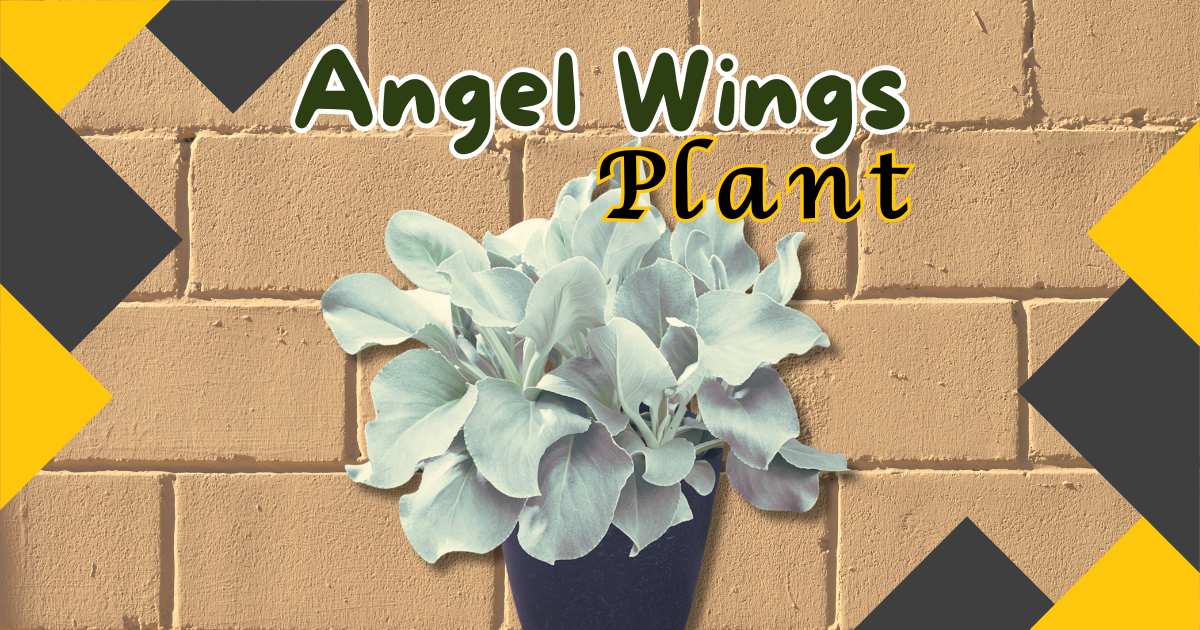The angel wings plant (Caladium bicolor) is known for its stunning, heart-shaped leaves and vibrant colors, making it a popular choice for both indoor and outdoor gardening enthusiasts. If you’re looking to add a touch of elegance to your home or garden, this plant is an excellent choice. In this article, we’ll share 5 essential tips for growing a healthy angel wings plant and provide all the information you need to keep your plant thriving.
What Is an Angel Wings Plant? A Complete Guide
The angel wings plant is a tropical perennial that is prized for its beautiful foliage. Native to South America, it features large, heart-shaped leaves with a variety of color patterns, including shades of green, red, pink, and white. The plant gets its name from the shape of its leaves, which resemble the wings of an angel.
Characteristics of the Angel Wings Plant:
- Leaf Patterns and Colors:
The leaves of the angel wings plant can be solid or variegated, often featuring a mix of vibrant colors. This makes it a striking addition to any indoor or outdoor space. - Size and Growth Habit:
The plant typically grows up to 24 inches tall and spreads about 12 to 18 inches wide. Its compact size makes it suitable for small spaces and container gardening. - Seasonal Growth:
This is a perennial, but its growth may slow down or go dormant in cooler months. With proper care, it will come back in full splendor during the growing season. - Non-Flowering Plant:
While the angel wings plant is primarily grown for its foliage, it occasionally produces small, inconspicuous flowers. However, the real appeal lies in its colorful leaves.
Knowing the characteristics of the angel wings plant helps you understand its needs and care requirements better, ensuring it thrives in your home or garden.
Angel Wings Plant Care: How to Keep Your Plant Thriving Indoors
Caring for an angel wings plant indoors requires attention to its specific needs, including light, water, and soil conditions. Here’s a comprehensive guide to keeping your plant healthy and vibrant.
Indoor Care Tips for Angel Wings Plant:
- Light Requirements:
These plant prefers bright, indirect light. Direct sunlight can scorch the leaves, while too little light can cause them to lose their vibrant colors. Place it near a window with filtered light for the best results. - Watering Schedule:
Water your plant regularly, but avoid overwatering. The soil should be kept moist but not soggy. Allow the top inch of soil to dry out between waterings to prevent root rot. - Humidity Levels:
The angel wings plant thrives in high humidity. If your home is dry, consider using a humidifier or placing the pot on a tray filled with pebbles and water to increase humidity around the plant. - Temperature Preferences:
This plant prefers temperatures between 65°F and 80°F. Avoid placing it near drafts, air conditioners, or heaters, as sudden temperature changes can stress the plant. - Fertilizing Routine:
Feed your plant with a balanced, water-soluble fertilizer every 4-6 weeks during the growing season (spring and summer). Reduce feeding in the fall and winter when growth slows down.
By following these indoor care tips, your angel wings plant will remain healthy and vibrant throughout the year.
How to Water Your Angel Wings Plant: Dos and Don’ts
Proper watering is crucial for the health of your angel wings plant. Overwatering or underwatering can lead to a variety of problems, including yellowing leaves, root rot, and stunted growth. Here’s a guide on how to water your plant correctly.
Dos for Watering Your Angel Wings Plant:
- Use Lukewarm Water:
Always use lukewarm water to avoid shocking the roots. Cold water can cause leaf spots and hinder the plant’s growth. - Water at the Base:
Water the plant at the base, directly onto the soil. Avoid getting water on the leaves, as this can lead to fungal infections. - Check Soil Moisture:
Use your finger or a moisture meter to check the soil’s moisture level before watering. The top inch of soil should be dry to the touch before you water again. - Adjust Watering Frequency:
Adjust your watering frequency based on the season. Water more frequently in the summer when the plant is actively growing and reduce watering in the winter.
Don’ts for Watering Your Angel Wings Plant:
- Don’t Overwater:
Overwatering is a common mistake that can lead to root rot. Make sure the pot has good drainage and never let the plant sit in water. - Don’t Water at Night:
Watering at night can cause excess moisture to linger on the leaves and soil, promoting fungal growth. Water your plant in the morning to allow it to dry out during the day. - Don’t Ignore Signs of Underwatering:
If the leaves start to droop or turn brown at the edges, it may be a sign that your plant isn’t getting enough water. Increase watering frequency and monitor the plant’s response.
By following these dos and don’ts, you can maintain proper moisture levels and keep your angel wings plant healthy and thriving.
Angel Wings Plant Propagation: A Step-by-Step Guide
Propagating an angel wings plant is a rewarding way to expand your collection or share this beautiful plant with friends and family. Here’s a step-by-step guide to propagating your plant successfully.
Steps to Propagate an Angel Wings Plant:
- Choose a Healthy Parent Plant:
Select a healthy, mature angel wings plant with strong stems and vibrant leaves. Avoid using plants that show signs of disease or stress. - Cut a Healthy Stem:
Using a sharp, clean pair of scissors or pruning shears, cut a 4-6 inch stem just below a leaf node. Make sure the cutting has at least two leaves and a few nodes. - Prepare the Cutting:
Remove the lower leaves from the cutting, leaving only the top set of leaves. This will reduce water loss and encourage root development. - Rooting in Water or Soil:
You can root the cutting in either water or soil. For water propagation, place the cutting in a glass of water, ensuring the nodes are submerged. For soil propagation, plant the cutting in a small pot filled with a well-draining potting mix. - Provide Ideal Conditions:
Keep the cutting in a warm, humid environment with bright, indirect light. If you’re rooting in water, change the water every few days to keep it fresh. - Transplanting:
Once the cutting has developed a healthy root system (usually after 2-4 weeks), transplant it into a pot with regular potting soil. Continue to care for it as you would a mature plant.
By following these steps, you can successfully propagate your angel wings plant and enjoy the beauty of this stunning plant in multiple locations around your home.
Looking for more plant care tips? Check out our guide on 7 Essential Tips for Wandering Jew Plant Care: How to Keep Your Plant Thriving for expert advice! Read it here.
Best Light and Soil Conditions for Angel Wings Plant Growth
Providing the right light and soil conditions is essential for the healthy growth of your angel wings plant. Here’s what you need to know to create the perfect environment for your plant.
Light Requirements for Angel Wings Plant:
- Bright, Indirect Light:
The angel wings plant thrives in bright, indirect light. Too much direct sunlight can scorch the leaves, while too little light can cause the plant to become leggy and lose its vibrant colors. - Filtered Sunlight:
Place your plant near a window with filtered sunlight, such as a sheer curtain or a location that receives morning sun and afternoon shade. - Artificial Lighting:
If natural light is limited, you can use artificial grow lights to supplement. Position the lights about 12 inches above the plant and keep them on for 12-14 hours a day.
Soil Requirements for Angel Wings Plant:
- Well-Draining Soil:
The angel wings plant prefers well-draining soil to prevent waterlogging and root rot. Use a high-quality potting mix with added perlite or sand for improved drainage. - Slightly Acidic to Neutral pH:
The ideal soil pH for this plant is between 6.0 and 7.0. You can test the soil pH with a home testing kit and amend it if necessary. - Organic Matter:
Adding organic matter, such as compost or peat moss, to the soil will improve its structure and provide essential nutrients for healthy growth.
By providing the right light and soil conditions, you’ll ensure your plant thrives and displays its beautiful foliage to the fullest.
Curious about lucky plants? Don’t miss out on these 5 Fascinating Facts About the Four Leaf Clover Plant You Need to Know—you’ll be amazed! Read more here.
Conclusion: Why the Angel Wings Plant Is a Beautiful Addition to Your Home
In conclusion, the angel wings plant is a stunning and versatile addition to any home or garden. With its vibrant colors, unique leaf shapes, and relatively easy care requirements, it’s a perfect choice for plant enthusiasts of all levels. Whether you’re looking to enhance your indoor decor or create a striking outdoor display, this plant offers endless possibilities.
By following the care tips and guidelines outlined in this article, you can enjoy the beauty of your angel wings plant for years to come. From watering and pruning to propagation and problem-solving, you now have all the information you need to keep your plant thriving. So add an angel wings plant to your collection today and experience the joy of this beautiful, low-maintenance plant.
FAQs About Angel Wings Plant
- What is an angel wings plant?
The angel wings plant (Caladium bicolor) is a tropical perennial known for its large, heart-shaped leaves with vibrant colors and patterns. - How do I care for an angel wings plant indoors?
Provide bright, indirect light, maintain consistent moisture in the soil, and keep the humidity high. Avoid direct sunlight and drafts. - What is the best way to water an angel wings plant?
Water the plant when the top inch of soil is dry. Use lukewarm water and avoid overwatering to prevent root rot. - Can I propagate an angel wings plant?
Yes, you can propagate the plant by taking stem cuttings and rooting them in water or soil. - What type of soil does an angel wings plant need?
Use well-draining soil with added perlite or sand. The soil should be slightly acidic to neutral with a pH of 6.0-7.0. - Why are the leaves of my angel wings plant turning yellow?
Yellowing leaves can be caused by overwatering, poor drainage, or low light conditions. Adjust watering and lighting to resolve the issue. - How can I increase humidity for my angel wings plant?
Use a humidifier, place the plant on a tray with water and pebbles, or mist the leaves regularly to maintain high humidity. - What should I do if my angel wings plant becomes leggy?
Move the plant to a brighter location and prune back leggy stems to encourage fuller growth. - Are angel wings plants safe for pets?
The angel wings plant is toxic to pets if ingested. Keep it out of reach of cats, dogs, and other animals. - Can I grow an angel wings plant outdoors?
Yes, the plant can be grown outdoors in USDA zones 9-11. Ensure it’s in a shaded area with well-draining soil and consistent moisture.
Emma Rose is a professional writer with over 3 years of experience covering a wide range of topics, including health, lifestyle, and technology. She is known for her in-depth research and commitment to providing accurate, trustworthy, and engaging content. Emma’s work focuses on delivering value to readers by simplifying complex topics and ensuring every article meets high editorial standards.




